It began with the National Cemetery
19 October 2018
I greatly enjoyed a rainy afternoon last Thursday in Sharpsburg, spending part of it at the Antietam National Cemetery. I’m working on a project tracing the history and evolution of the Antietam National Battlefield, and the Cemetery, created shortly before the Battlefield was established, is a big part of that story.
But it is also a beautiful place in its own right, so I hope neither of my readers will object if I hit some highlights.
The 11 and 1/4 acre plot on which the cemetery is laid out was purchased by funds appropriated by the legislature of Maryland in March 1865. The State also appointed the Antietam National Cemetery Board, as Trustees of the state, to oversee construction of the cemetery and arrange the re-burial of soldiers who died in Allegany, Washington, and Frederick Counties, Maryland during the War.
The original intent of the Legislature was to bury troops from both sides, Confederate and Union, but continuing post-War animosity between the sides and a lack of funding support from the former Confederate states, led to only Northern men being buried here.
Confederate soldiers who died at Sharpsburg and elsewhere in Maryland were reinterred at Rose Hill in Hagerstown (very few identified, all buried as unknowns) about 1874. Others are found in Mt. Olivet in Frederick, and Elmwood in Shepherdstown, VA.
The Cemetery Board raised about $70,000 from 18 Northern states in 1866 to do the work of establishing the Cemetery.
At a meeting held in September 1866, a design for an iron fence and gateway for the front line of the grounds was agreed upon, and, according to instruction of the Board, a contract was made with Messrs. Robert Wood & Co. of Philadelphia, for a wrought iron fence, at six dollars per foot, and also for the gateway, at a cost of $880. It is substantial as well as ornamental, and its entire length is six hundred and six feet, eight inches without the gateway, which latter is twenty-six feet in width – sufficiently capacious to admit vehicles to pass each other in their ingress and egress.
A massive stone wall surrounds other portions of the grounds, of which it can be said in truth, that no more solid and durable wall has been erected for an enclosure for any other Cemetery in the country. The wall is of uniform height, on the inside of five feet, including the coping, and varying on the outside from the height last named to ten and fifteen feet, owing to the unevenness of the surrounding ground, which is rolling and broken in character, as were the grounds before filling up and grading the same.
Near the entrance to the Cemetery, and within its enclosure, has been erected a neat and commodious Lodge House, designed for the occupancy of the keeper of the grounds, and the comfort and convenience of visitors.
The Gothic Revival lodge was designed by Paul J. Pelz, who was also a lighthouse designer and later architect of the Library of Congress (1873-92).
By September 1867 the cemetery was completed and 4,667 soldiers’ remains had been interred there, more than 1,800 of them unidentified. There have been additional burials in the years since, and now about 5,000 people rest in the Cemetery.

Dedication of the National Cemetery (NPS)
President Andrew Johnson was among the many dignitaries who spoke at the dedication ceremony on 17 September 1867:
My Fellow Countrymen: In appearing before you it is not for the purpose of making any lengthy remarks, but simply to express my approbation of the ceremonies which have taken place to-day … but I must be permitted to express my hope that we may follow the example which has been so eloquently alluded to this afternoon, and which has been so clearly set by the illustrious dead. When we look on yon battle field I think of the brave men on both sides, who fell in the fierce struggle of battle, who sleep silent in their graves. Yes, who sleep in silence and peace after the earnest conflict has ceased. Would to God we of the living could imitate their example, as they lay sleeping in peace in their tombs, and live together in friendship and peace …
Also at that ceremony, a cornerstone was laid for a huge memorial to be placed in the cemetery later:
In the centre of the ground plan of the Cemetery is an open space devoted to the erection of a monument commemorative of the great event of the battle, and the heroism of those who sleep at its foot and around it. The design of the monument, which was adopted at a meeting of the Board, held in the city of Baltimore, on the 16th day of September, 1867, seems to meet all requirements in a military, national, and patriot point of view. It is the Colossal Statue of an American Soldier standing guard over the remains of the loyal dead, and, when completed, will be the largest work of its kind in the country.

Old Simon, 1876, with sculptor/designer Carl Conrads
The statue was designed by sculptor Carl Conrads and architect George Keller of the New England Granite Works, Hartford, CT, and executed in Rhode Island granite by a team of stone carvers in Westerly, RI, all under contract to the Cemetery Board. Now known as “Old Simon”, he’s 21 and 1/2 feet tall, weighs 29 tons, and stands on a monumental base which is just over 44 and 1/2 feet tall and 250 tons. He was completed in early 1876 and exhibited at the Centennial Exhibition in Philadelphia in May of that year. He was finally installed at the Cemetery after the Board made the last, delinquent payment on him, and was dedicated on 17 September 1880, 18 years after the battle.
That’s him in the background of the photo at the top of this page, of course.
The Cemetery Board turned the operation and maintenance of the Cemetery over to the US War Department in 1877, and the state of Maryland deeded the land to the US Government in 1878. It became part of the Battlefield Park in 1933 when the US Park Service took over management from the War Department.
Before the Park Service built the current battlefield Visitor Center in 1961-62, the Keeper’s (Superintendent’s) Lodge at the Cemetery was the only public structure associated with the battlefield of Antietam. As such, it held a modest museum and facilities for visitors, and was often the gathering point for people coming to see the battlefield. It wasn’t until 1900 that a separate, dedicated Superintendent was authorized for the Battlefield, so until then the Lodge’s resident served in both roles.
The main reason for the Cemetery though, today as then, is to honor the dead who lie there. Here are a small sample of the their stones:
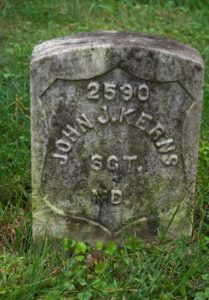
Sergeant John J. Kerns (c.1832-1864), Company B, First Potomac Home Brigade (Maryland) Cavalry. Enlisted 24 August 1861, KIA at Clear Spring, MD on 10 January 1864, age 32.
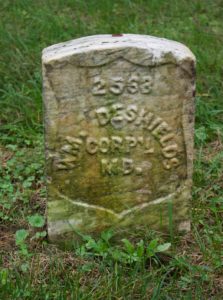
Corporal William DeShields (?-1864), Company K, First Potomac Home Brigade Cavalry. Enlisted 26 February 1864, promoted Corporal, KIA at Keedysville, MD on 6 August 1864.

Private William Sendner (Sender) (c.1841-1864), Battery B, 5th United States Artillery. b. Bavaria, shoemaker; enlisted 23 January 1863, New York, died on 30 July 1864 of typhoid fever at Cumberland, MD.

Private Morgan Foley (c.1839-1862), Company H, 14th United States Infantry. b. Ireland, boatman; enlisted 24 April 1862, Rochester, NY; hospitalized in Frederick, MD on 1 November and died there of disease 24 November 1862.
___________
Notes
The quotes here are from the History of Antietam National Cemetery (1869), beautifully presented online by WHILBR, at the Western Maryland Regional Library, Hagerstown.
The somewhat fanciful illustration of the 1867 Dedication is from the Antietam National Battlefield collection. It’s online at the ANB website.
“Old Simon” is from an 1876 stereo photograph in the New York Public Library.
I made the other photos here at the Cemetery on 11 October 2018. I particularly love the ironwork of the fence and gate.


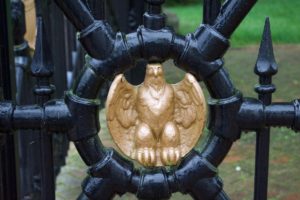
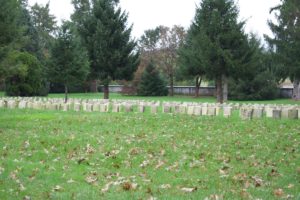
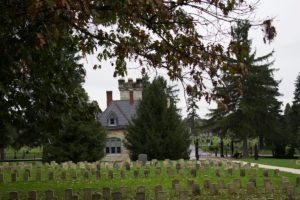

Please Leave a Reply